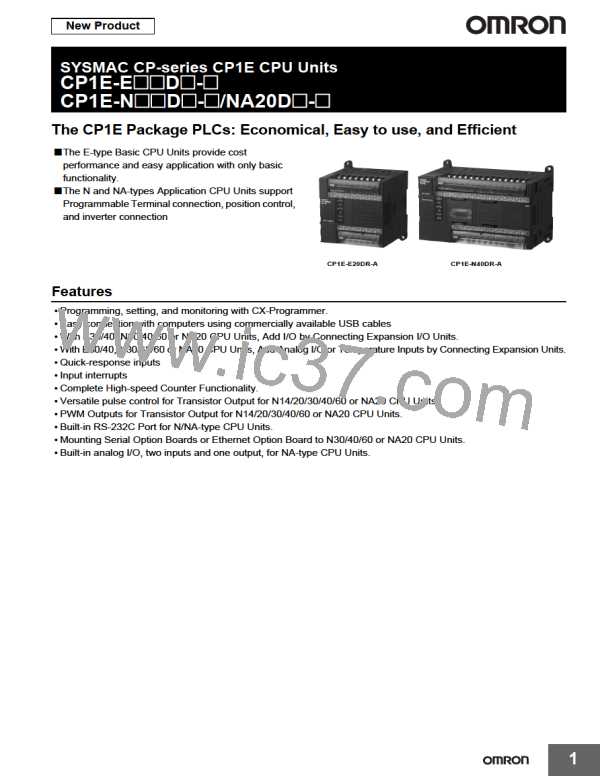CP1E-E@@D@-@ CP1E-N@@D@-@/NA20D@-@
Function
Function description
Holding Area data, DM Area data, Counter Completion Flags, and counter present values
are held even when power is turned OFF.
This function can be used only with an N/NA-type CPU Unit and only when the Battery Set
(sold separately) is mounted.
Memory protection
Power supply
management
Number of power interruptions counter
Online editing
The number of times power has been interrupted is counted.
The program can be changed during operation in MONITOR mode or PROGRAM mode.
Specified bits can be set or reset.
Force-set/reset
Differentiate monitoring
Storing the stop position at errors
ON/OFF changes in specified bits can be monitored.
Debugging
The location and task number where execution stopped for a program error is recorded.
The programs can be checked for items such as no END instruction and FALS/FAL errors
at startup.
Program check
Error Log
Details and the time of occurrence of error codes predefined by the CPU Unit are stored.
CPU Unit WDT errors are detected.
CPU error detection
Errors can be generated for user-specified conditions:
Non-fatal errors (FAL) and fatal errors (FALS).
User-defined failure diagnosis
Load OFF function
The built-in outputs, Expansion I/O Unit outputs, and Expansion Unit outputs are turned
OFF.
System FAL error detection
(User-defined non-fatal error)
This function generates a non-fatal (FAL) error when the user-defined conditions are met
in program.
This function detects when data in the backup memory (built-in EEPROM) that stores the
ladder program is corrupted.
Backup memory error detection
PLC Setup error detection
Non-fatal error
detection
This function detects setting errors in the PLC Setup.
Option Board errors
This function detects when the Option Board is malfunctioning or disconnected.
This function detects when the battery voltage is low or the battery is disconnected.
Battery error detection
(N/NA-type CPU Units only)
Note: This function is valid only when a battery is mounted and the Do not detect battery
error Check Box is cleared in the PLC Setup.
This function detects when a built-in analog I/O error occurs and stops the operation of built-
in analog I/O.
Built-in analog error
Memory error detection
I/O bus error detection
This function detects errors that occur in memory of the CPU Unit.
This function detects errors that occur during data transfer between the CPU Unit and
another Unit.
Too Many I/O Points Error
Detection
This function detects when more than the maximum number of CP1W Expansion I/O Units
and Expansion Units are connected to the PLC.
Self-diagnosis
and restoration
This function detects when there is an error in the program.
See the following for details.
Program error detection
Instruction processing error This function detects an error when the given data value is invalid when executing an
detection
instruction, or execution of instruction between tasks was attempted.
Indirect DM addressing BCD
error
This function detects an error when an indirect DM address in BCD mode is not BCD.
Illegal area access error
detection
This function detects an error when an attempt is made to access an illegal area with an
instruction operand.
Fatal Error
Detection
No END error detection
This function detects an error when there is no END instruction at the end of the program.
The execution condition for an interrupt task was met but there is no interrupt task with the
specified number.
Task error detection
This function detects an error when too many differentiated instructions are entered or
deleted during online editing (131,072 times or more).
overflow error detection
Invalid instruction error
detection
This function detects an error when an attempt is made to execute an instruction that is not
defined in the system.
User program area overflow This function detects an error when instruction data is stored after the last address in user
error detection
program area.
Cycle time exceeded error
detection
This function monitors the cycle time (10 to 1,000 ms) and stops the operation when the set
value is exceeded.
System FALS error detection
(user-defined fatal error)
This function generates a fatal (FALS) error when the user-defined conditions are met in
program.
This function enables automatically connecting to the PLC online when the CX-Programmer
is directly connected by a serial connection (peripheral USB port or serial port).
Maintenance
Automatic online connection via network
This function protects user memory.
Read protection using password
Read protection: Set a password using the CX-Programmer.
Overwrite protection is not provided.
Security
functions
Write protection from FINS commands
This function prohibits writing by using FINS commands sent over the network.
12

 OMRON [ OMRON ELECTRONICS LLC ]
OMRON [ OMRON ELECTRONICS LLC ]